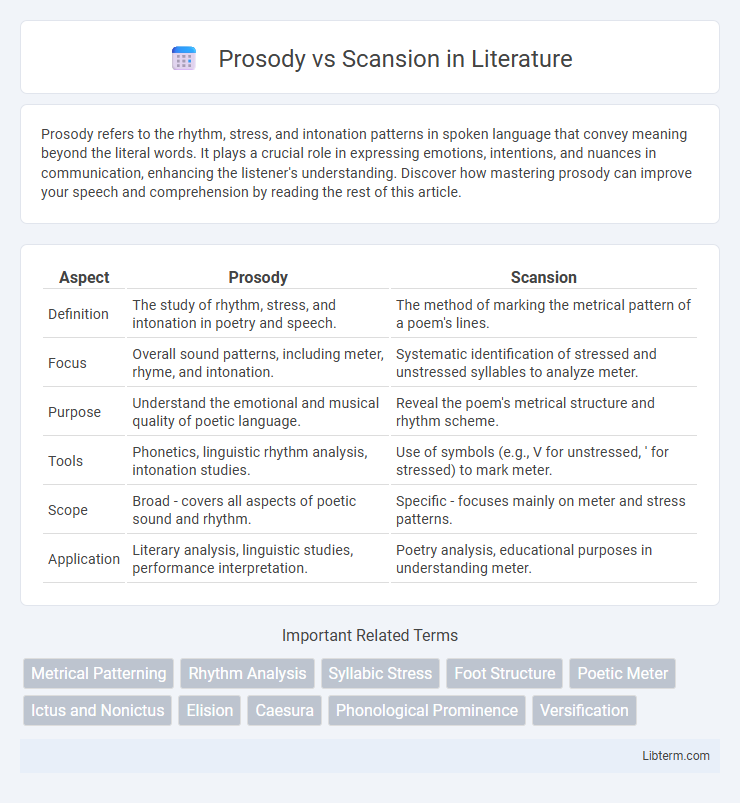Prosody refers to the rhythm, stress, and intonation patterns in spoken language that convey meaning beyond the literal words. It plays a crucial role in expressing emotions, intentions, and nuances in communication, enhancing the listener's understanding. Discover how mastering prosody can improve your speech and comprehension by reading the rest of this article.
Table of Comparison
| Aspect | Prosody | Scansion |
|---|---|---|
| Definition | The study of rhythm, stress, and intonation in poetry and speech. | The method of marking the metrical pattern of a poem's lines. |
| Focus | Overall sound patterns, including meter, rhyme, and intonation. | Systematic identification of stressed and unstressed syllables to analyze meter. |
| Purpose | Understand the emotional and musical quality of poetic language. | Reveal the poem's metrical structure and rhythm scheme. |
| Tools | Phonetics, linguistic rhythm analysis, intonation studies. | Use of symbols (e.g., V for unstressed, ' for stressed) to mark meter. |
| Scope | Broad - covers all aspects of poetic sound and rhythm. | Specific - focuses mainly on meter and stress patterns. |
| Application | Literary analysis, linguistic studies, performance interpretation. | Poetry analysis, educational purposes in understanding meter. |
Understanding Prosody: Definition and Importance
Prosody refers to the rhythm, stress, and intonation patterns in spoken language, crucial for conveying emotion and meaning beyond literal words. Understanding prosody enhances speech recognition, natural language processing, and poetry analysis by revealing the underlying structure and flow of language. Its importance lies in improving communication clarity, emotional expression, and cognitive processing of verbal information.
Scansion Explained: Breaking Down Poetic Meter
Scansion is the detailed analysis of a poem's meter, involving marking stressed and unstressed syllables to reveal its rhythmic structure. This technique helps identify patterns such as iambic pentameter, trochaic tetrameter, or dactylic hexameter, which contribute to a poem's musicality and flow. By breaking down poetic meter, scansion provides insight into how rhythm influences meaning and emotional impact within poetry.
Core Differences Between Prosody and Scansion
Prosody analyzes the rhythm, stress, and intonation patterns in spoken language, emphasizing how these elements convey meaning and emotion. Scansion specifically examines the metrical structure of poetry, identifying patterns of stressed and unstressed syllables to determine the poem's meter. Core differences lie in prosody's broader application to speech sounds and expressive qualities, while scansion focuses narrowly on the formal rhythmic pattern within poetic lines.
The Role of Rhythm in Prosody
Rhythm in prosody shapes the natural flow and emotional tone of spoken language, influencing how meaning is conveyed through variations in pitch, tempo, and stress patterns. Scansion systematically analyzes this rhythm by marking stressed and unstressed syllables to reveal the underlying metrical structure of poetry. Understanding rhythm's role in prosody enhances interpretation and performance, making the distinction between rhythmic patterns in speech and the formal meter in poetry clear.
Methods and Tools Used in Scansion
Scansion involves systematic methods such as marking stressed and unstressed syllables, identifying metrical feet, and analyzing rhythmic patterns within a poem. Tools used in scansion range from traditional handwritten annotations to digital software like Prosody Analyzer and online scansion apps that assist in detecting meter and syllabic emphasis. These tools enhance accuracy by providing visual aids and automated stress pattern detection, facilitating deeper metrical analysis in poetic texts.
Analyzing Stress Patterns: Prosody vs Scansion
Analyzing stress patterns in poetry involves understanding prosody as the broader study of rhythm, intonation, and meter, while scansion specifically identifies stressed and unstressed syllables within a verse. Prosody encompasses the musical qualities of language, including variations in pitch, tempo, and emphasis, which contribute to a poem's emotional tone. Scansion systematically marks these stress patterns, revealing the underlying metrical structure that shapes the poem's rhythm and flow.
Prosody’s Impact on Poetic Interpretation
Prosody, encompassing elements like intonation, stress, and rhythm, plays a crucial role in shaping a reader's emotional and interpretive response to poetry. Unlike scansion, which mechanically marks metrical patterns, prosody captures the natural flow and musicality of language, enhancing meaning and mood. The nuanced variations in prosodic features can reveal subtext and deepen the understanding of poetic structure and thematic intent.
Common Scansion Symbols and Terminology
Prosody examines the rhythm, stress, and intonation patterns in speech and poetry, while scansion specifically analyzes the metrical structure of verses. Common scansion symbols include the macron (-) for stressed syllables, the breve (V) for unstressed syllables, and vertical bars (|) to mark metrical feet or caesuras. Terminology such as iamb, trochee, dactyl, and anapest define patterns of syllabic stress essential for identifying meter in poetic lines.
Examples: Comparing Prosodic and Scansion Analysis
Prosody examines the natural rhythm, stress, and intonation patterns in speech, as demonstrated in poetry lines like Shakespeare's "Shall I compare thee to a summer's day?" where the flow reflects emotion and emphasis. Scansion, however, provides a mechanical breakdown of metrical feet, marking stressed and unstressed syllables, such as iambic pentameter in the same line, identifying a structured five-foot pattern. Comparing both analyses highlights prosody's focus on expressive elements versus scansion's emphasis on metrical form and pattern regularity.
Enhancing Poetry Analysis: Combining Prosody and Scansion
Combining prosody and scansion enriches poetry analysis by integrating the study of rhythmic patterns with the detailed marking of stressed and unstressed syllables. Prosody examines the emotional tone and intonation of a poem, while scansion provides a systematic framework to decode meter and rhythm. Utilizing both techniques reveals deeper layers of meaning and enhances the understanding of a poem's structural and sonic qualities.
Prosody Infographic

 libterm.com
libterm.com